Synsam Bundle
Who Really Owns Synsam Group?
Understanding the Synsam SWOT Analysis is crucial, but have you ever wondered who pulls the strings at Synsam Group? The ownership structure of a company is a roadmap to its future, influencing everything from innovation to market strategy. This exploration dives deep into the ownership of Synsam, a leading optical retailer in the Nordic region, to uncover the forces shaping its decisions and future trajectory.
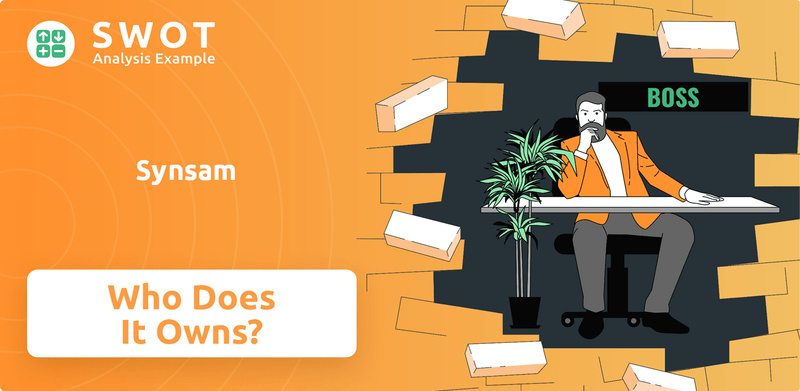
From its founding in 1968 to its IPO in 2021, Synsam's ownership has undergone a significant transformation. This shift from private equity to public ownership provides key insights into the company's strategic direction and financial performance. This analysis will explore the evolution of Synsam's ownership, including the impact of major shareholders and the board of directors on the company's governance and future plans. Discover the details of Synsam's ownership and management team.
Who Founded Synsam?
The specifics of the original equity split and shareholding percentages of the founders of the company, established in 1968, are not readily accessible in public records. The company was formed through a collaboration of independent opticians in Sweden. Their goal was to create a stronger presence in the optical market.
The early ownership structure likely involved these independent opticians holding direct stakes in the collective entity, with decisions made through a collaborative framework. The company's beginnings were more like a merger or alliance of existing businesses rather than a typical startup with angel investors.
The company's initial structure was built on a cooperative model. Participating opticians pooled resources and expertise. The founding team's vision was to create a unified and strong optical retail chain in the Nordics, which was reflected in this initial cooperative distribution of control, emphasizing shared growth and market influence.
The founders aimed to establish a strong optical retail chain in the Nordic region. Their vision was to create a unified presence.
The company was built on a cooperative model, where opticians pooled their resources. This approach allowed for shared expertise and growth.
Independent opticians likely held direct stakes in the collective entity. Decisions were made through a collaborative framework.
The initial cooperative structure emphasized shared growth and market influence. This approach helped the company become a strong player.
There were no significant early angel investors or 'friends and family' rounds. The company's genesis was more of a merger.
Detailed information on equity splits and shareholding percentages is not available in public records. The company's early history is not widely publicized.
Understanding the Marketing Strategy of Synsam provides additional context on how the company evolved from its cooperative roots to its current market position. The early focus on collaboration among opticians shaped the company's approach to market influence and growth.
The company's founding was a collaborative effort among independent opticians. The initial ownership structure was based on a cooperative model.
- The exact names and individual contributions of all initial founders are not widely publicized.
- The company's early phases involved independent opticians holding direct stakes.
- There are no public records of significant early angel investors.
- The founding team aimed to create a unified and strong optical retail chain.
Synsam SWOT Analysis
- Complete SWOT Breakdown
- Fully Customizable
- Editable in Excel & Word
- Professional Formatting
- Investor-Ready Format
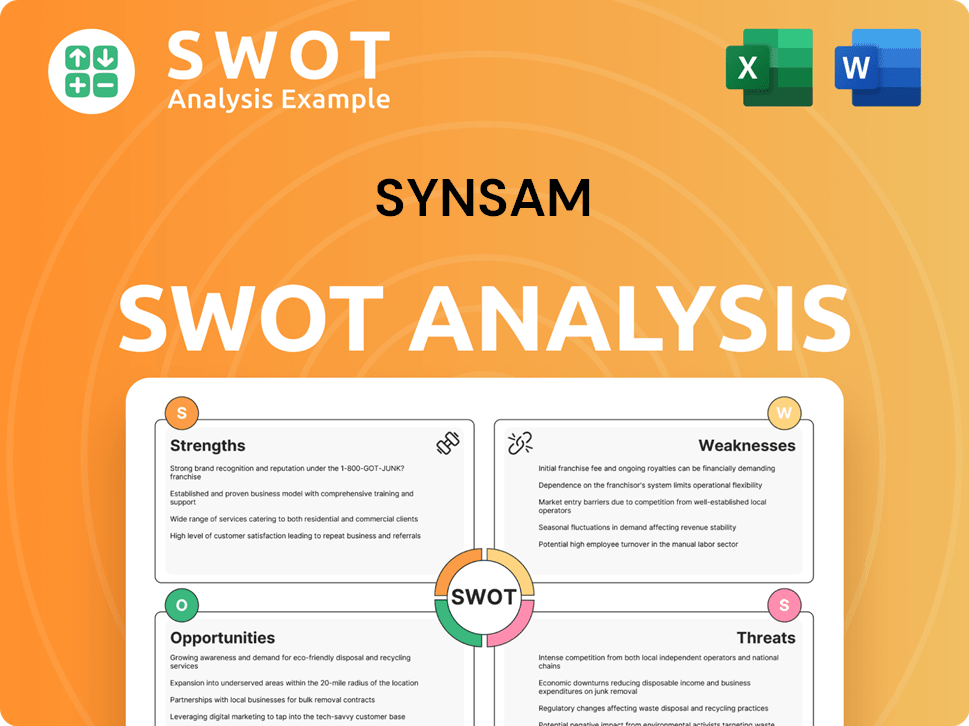
How Has Synsam’s Ownership Changed Over Time?
The ownership structure of Synsam Group has been significantly shaped by private equity involvement and a subsequent Initial Public Offering (IPO). Before the IPO, private equity firms primarily owned the company. CVC Capital Partners acquired Synsam in 2014 from Alipes, another private equity firm. This acquisition brought in substantial capital and strategic direction, which helped Synsam expand its operations and strengthen its market position in the Nordic region.
The most critical event in Synsam's ownership history was its IPO on Nasdaq Stockholm in October 2021. This IPO valued Synsam at approximately SEK 18.5 billion (around $2.1 billion USD at the time). CVC Capital Partners remained a significant shareholder after the IPO, although its stake was reduced. The transition from private equity ownership to a public shareholder base has generally increased transparency and a focus on public market performance.
| Event | Date | Impact |
|---|---|---|
| CVC Capital Partners Acquisition | 2014 | Significant capital infusion and strategic oversight, leading to expansion. |
| Initial Public Offering (IPO) | October 2021 | Valued Synsam at approximately SEK 18.5 billion; CVC remained a significant shareholder. |
| Ongoing Market Trading | Early 2025 | Ownership percentages of institutional investors fluctuate. |
As of early 2025, the major stakeholders in Synsam Group include a mix of institutional investors, mutual funds, and remaining private equity interests. While specific percentages change due to market trading, prominent institutional investors typically hold significant stakes. For example, as of March 31, 2024, CVC Capital Partners VIII S.à r.l. held 19.8% of the shares. Other significant shareholders include Handelsbanken Fonder with 8.5%, Swedbank Robur Fonder with 6.6%, and If Skadeförsäkring AB with 4.8%. For more information, you can read about the Target Market of Synsam.
Synsam's ownership has evolved from private equity to a public company, with major institutional investors holding significant stakes.
- CVC Capital Partners played a crucial role in Synsam's growth.
- The IPO in 2021 marked a significant shift in ownership structure.
- Institutional investors like Handelsbanken Fonder and Swedbank Robur Fonder are key shareholders.
- The ownership structure is dynamic, with percentages subject to market fluctuations.
Synsam PESTLE Analysis
- Covers All 6 PESTLE Categories
- No Research Needed – Save Hours of Work
- Built by Experts, Trusted by Consultants
- Instant Download, Ready to Use
- 100% Editable, Fully Customizable
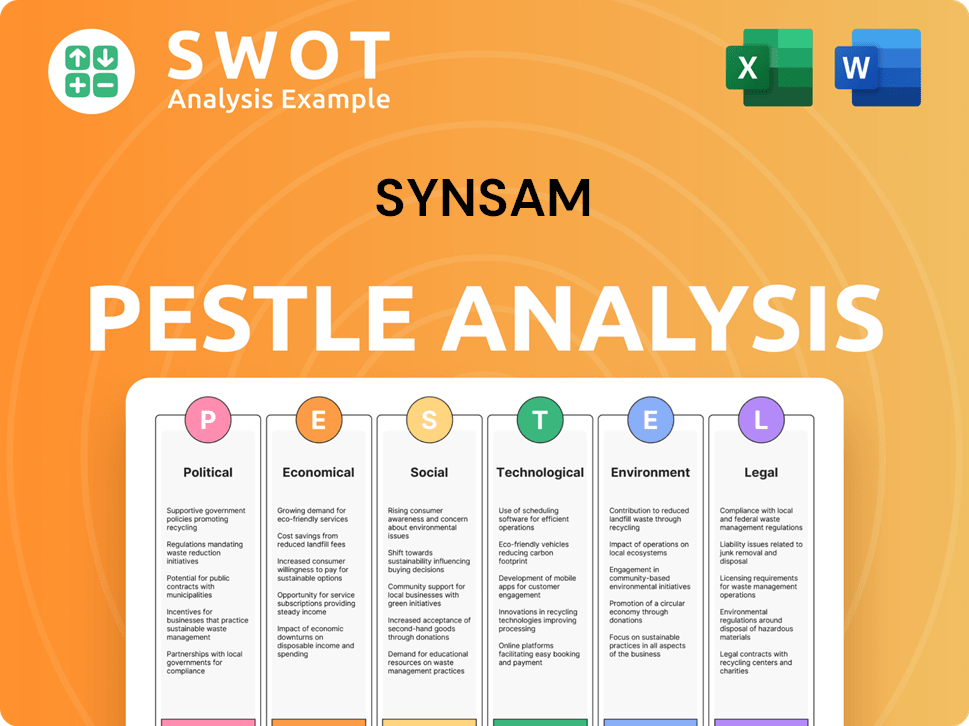
Who Sits on Synsam’s Board?
As of early 2025, the board of directors for Synsam Group typically includes a mix of representatives from major shareholders, independent members, and executive leadership. The Chairman of the Board often serves as an independent member, providing external oversight. Board members representing significant shareholders would hold seats proportional to their ownership. The composition reflects a balance between different interests to ensure effective governance. The company's governance is designed to ensure accountability and strategic alignment with shareholder interests.
The board members usually bring extensive experience from the retail, finance, and optical industries. This diverse background helps in making informed decisions about the company's strategic direction and operational performance. The presence of independent directors is crucial for balanced decision-making and protecting the interests of all shareholders. This structure supports the company's commitment to transparency and good corporate governance, which is important for maintaining investor confidence and ensuring long-term value creation.
| Board Member | Role | Notes |
|---|---|---|
| Chairman | Independent | Provides external oversight |
| Board Members | Shareholder Representatives | Proportional to ownership stake |
| Board Members | Executive Leadership | Represents company management |
Synsam Group operates with a one-share-one-vote voting structure, common for companies listed on Nasdaq Stockholm. This means each share has equal voting power, promoting a democratic governance model where shareholder influence is directly proportional to ownership. There are no publicly disclosed details of dual-class shares or special voting rights that would grant outsized control beyond direct shareholding. This structure ensures that all shareholders have a voice in the company's decisions, based on the number of shares they own. The Synsam owner structure is designed to be straightforward and transparent.
Synsam's governance structure ensures accountability and alignment with shareholder interests. The board includes independent directors and representatives from major shareholders. The company's one-share-one-vote system promotes fair voting rights.
- Board composition balances shareholder and independent interests.
- One-share-one-vote system ensures equal voting power.
- Transparency in governance enhances investor confidence.
- The company's structure is designed to be transparent and straightforward.
Synsam Business Model Canvas
- Complete 9-Block Business Model Canvas
- Effortlessly Communicate Your Business Strategy
- Investor-Ready BMC Format
- 100% Editable and Customizable
- Clear and Structured Layout
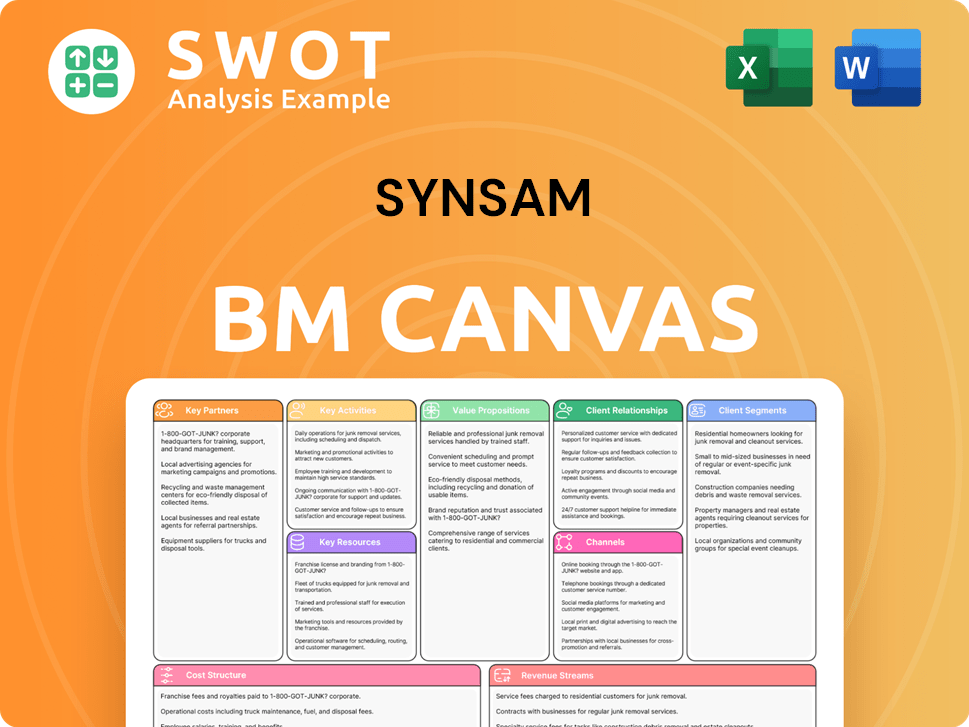
What Recent Changes Have Shaped Synsam’s Ownership Landscape?
Over the past few years, the ownership structure of Synsam Group has seen significant shifts, largely influenced by its initial public offering (IPO) and subsequent market activities. The IPO on Nasdaq Stockholm in October 2021 marked a pivotal moment, broadening its ownership base beyond its previous private equity owner, CVC Capital Partners. As of March 31, 2024, CVC Capital Partners remained a major shareholder, holding a substantial 19.8% stake, indicating a strategic, phased exit strategy to realize value while still participating in Synsam's growth.
Another key trend is the increasing presence of institutional investors. Major fund managers, such as Handelsbanken Fonder, which held 8.5%, and Swedbank Robur Fonder, with 6.6%, as of March 31, 2024, have become significant shareholders. This shift highlights a broader market trend where institutional investors are attracted to stable, growing companies. This often leads to greater scrutiny of corporate governance and financial performance. The evolution of the Growth Strategy of Synsam also influences the ownership landscape.
| Shareholder | Percentage of Shares (as of March 31, 2024) | Notes |
|---|---|---|
| CVC Capital Partners | 19.8% | Significant reduction post-IPO |
| Handelsbanken Fonder | 8.5% | Institutional Investor |
| Swedbank Robur Fonder | 6.6% | Institutional Investor |
The optical retail industry's focus on subscription models, which Synsam has adopted with its 'Synsam Lifestyle' subscription, also impacts its ownership profile. This model attracts investors looking for recurring revenue and customer loyalty, potentially drawing investors who value long-term growth and stable cash flows. While there have been no immediate announcements about succession plans or potential privatization, the company's performance and market conditions will continue to shape its ownership landscape.
The ownership of Synsam has evolved since its IPO. Major shareholders include CVC Capital Partners, which has decreased its stake. Institutional investors also hold significant portions of the company.
Major shareholders include CVC Capital Partners, Handelsbanken Fonder, and Swedbank Robur Fonder. Their holdings reflect the institutional interest in Synsam.
The company's market capitalization and financial performance impact its ownership structure. Changes in the market can lead to shifts in major shareholders.
Subscription models and industry trends will continue to influence Synsam's investor base. The company's strategic decisions will shape its ownership.
Synsam Porter's Five Forces Analysis
- Covers All 5 Competitive Forces in Detail
- Structured for Consultants, Students, and Founders
- 100% Editable in Microsoft Word & Excel
- Instant Digital Download – Use Immediately
- Compatible with Mac & PC – Fully Unlocked
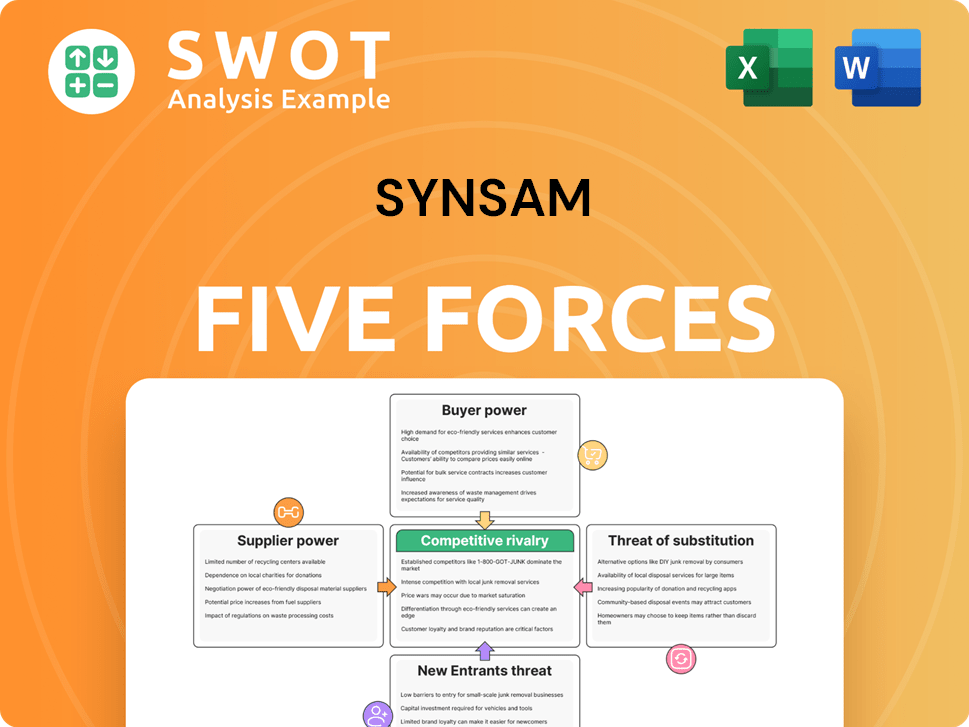
Related Blogs
- What are Mission Vision & Core Values of Synsam Company?
- What is Competitive Landscape of Synsam Company?
- What is Growth Strategy and Future Prospects of Synsam Company?
- How Does Synsam Company Work?
- What is Sales and Marketing Strategy of Synsam Company?
- What is Brief History of Synsam Company?
- What is Customer Demographics and Target Market of Synsam Company?
Disclaimer
All information, articles, and product details provided on this website are for general informational and educational purposes only. We do not claim any ownership over, nor do we intend to infringe upon, any trademarks, copyrights, logos, brand names, or other intellectual property mentioned or depicted on this site. Such intellectual property remains the property of its respective owners, and any references here are made solely for identification or informational purposes, without implying any affiliation, endorsement, or partnership.
We make no representations or warranties, express or implied, regarding the accuracy, completeness, or suitability of any content or products presented. Nothing on this website should be construed as legal, tax, investment, financial, medical, or other professional advice. In addition, no part of this site—including articles or product references—constitutes a solicitation, recommendation, endorsement, advertisement, or offer to buy or sell any securities, franchises, or other financial instruments, particularly in jurisdictions where such activity would be unlawful.
All content is of a general nature and may not address the specific circumstances of any individual or entity. It is not a substitute for professional advice or services. Any actions you take based on the information provided here are strictly at your own risk. You accept full responsibility for any decisions or outcomes arising from your use of this website and agree to release us from any liability in connection with your use of, or reliance upon, the content or products found herein.